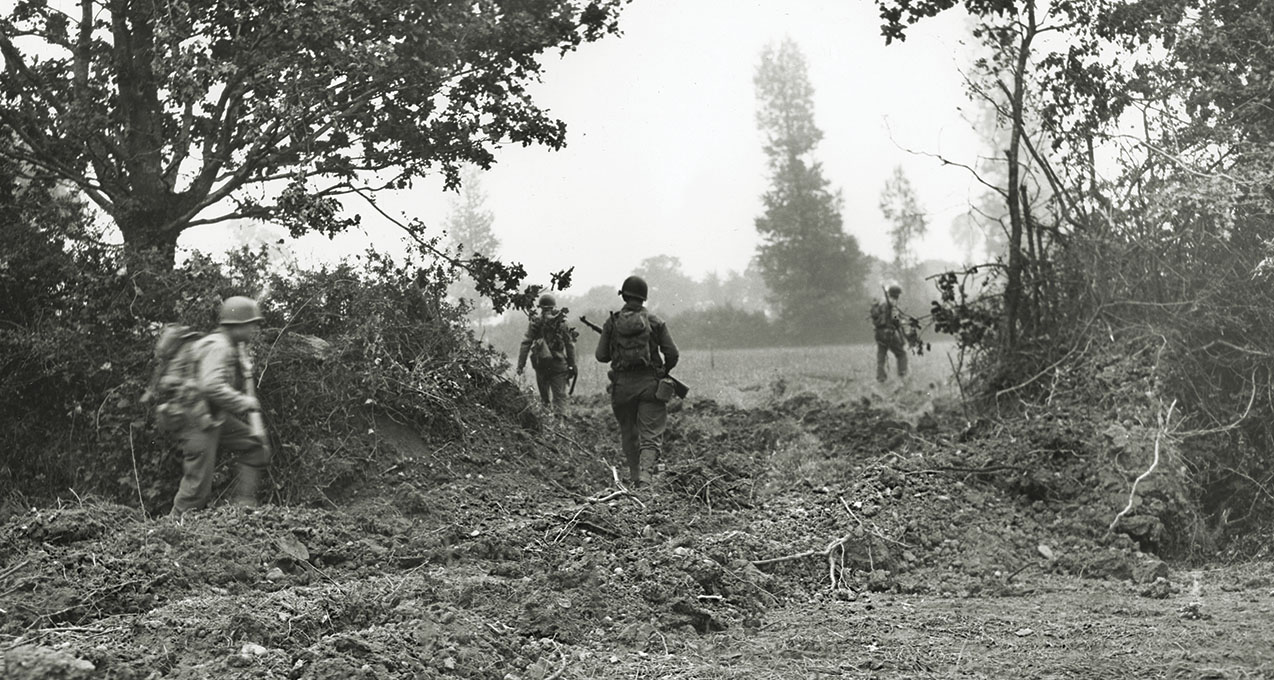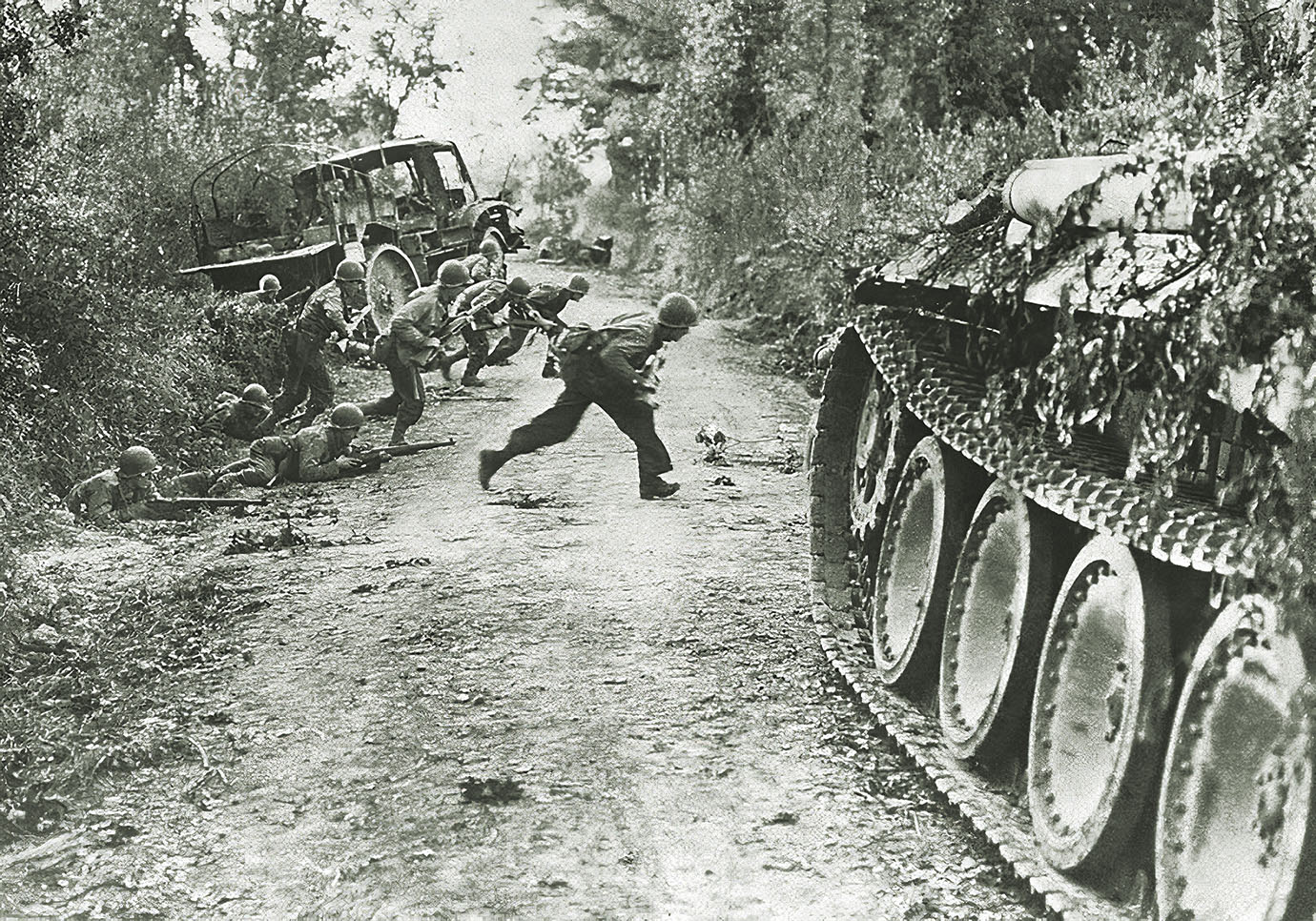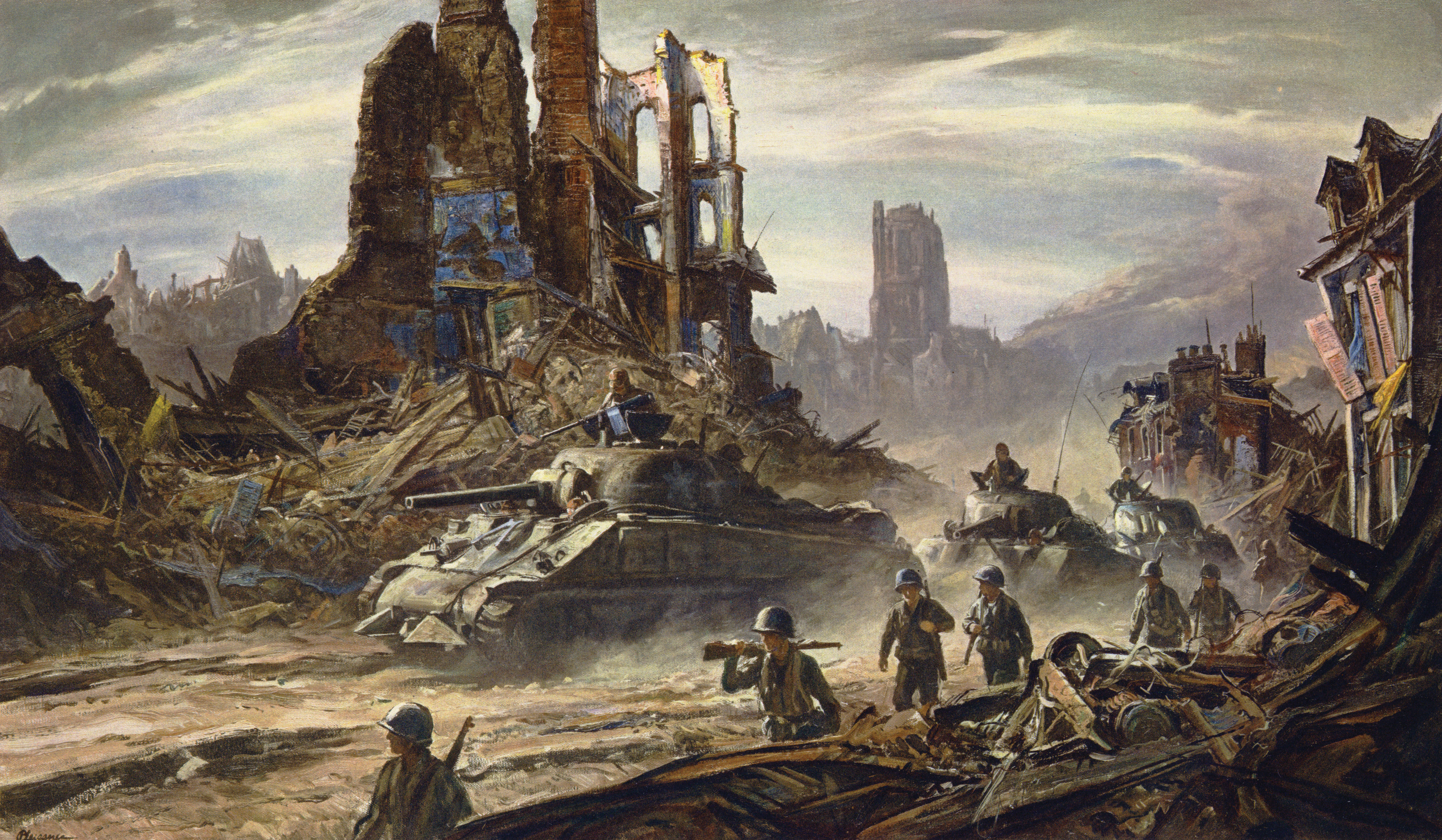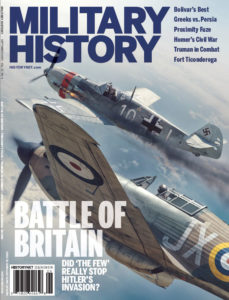It took tens of thousands of lives and weeks of fighting through the bedeviling Norman hedgerows to capture what remained of the ‘Capital of Ruins’
The Allied forces’ hard-won foothold on the bloody beaches of Normandy, France, on D-Day, June 6, 1944, was only the beginning of what would become a costly, foot-slogging effort to retake—field by field, town by town and house by house—all French ground the Germans had occupied since 1940. Myriad small farms and villages on the Allies’ line of march paid a bitter price for their liberation, with entire towns left in rubble and thousands of citizens killed. Among the hardest hit was the village of Saint-Lô.
Within 20 miles of the Normandy coast, the once-picturesque community of 11,000 had long been the provincial seat of the Manche government. It also had the wartime misfortune to straddle the junction of seven roads and a railroad line. The vital crossroads was a key to the success of the Allied invasion. As historian Ted Neill wrote, “Taking [Saint-Lô] would allow the Allies access to the entire region and provide an avenue of advance toward Paris.”
The Americans were well aware of this, as were the Germans. On D-Day the Allies had bombed the town’s power plant, railroad station and most other buildings in an effort to prevent enemy troops and tanks from passing through. American and British planes had dropped leaflets over the town the day before, warning citizens to evacuate. But strong winds had scattered the flyers, leaving residents unaware of what would befall them. The resulting mortality list approached 800, including dozens of French partisans the Germans were holding in Saint-Lô Prison, which was reduced to rubble. Before the campaign was over, Saint-Lô would be bombed twice more by the Allies and once by the Germans. Nearly the entire town was leveled, earning it the chilling epithet, the “Capital of Ruins.”
The hellish contest for the crossroads and the miles of tangled countryside leading to it was destined to become one of the bloodiest in the European Theater of Operations. In less than three weeks it cost thousands of GI lives, with tens of thousands more wounded or missing.
By the beginning of July 1944—three weeks after D-Day—Operation Overlord, the Allied invasion of Normandy, was not progressing as rapidly as anticipated. The British Second Army had yet to secure one of its primary objectives, the pivotal crossroads city of Caen, effectively halting its advance on Paris before it began. To block the Second Army the Germans had deployed a staggering force of tanks and armored fighting vehicles along a tight 20-mile front.
Farther to the west the American First Army under Lt. Gen. Omar Bradley had just achieved its first tactical objective by seizing the port city of Cherbourg, on the northern tip of the Cotentin Peninsula. But with the exception of V Corps, which had begun its southward push on June 9, First Army had progressed no further in breaking out of the peninsula. Resupplied and reinforced, Bradley ultimately launched an early July offensive, consisting of 14 divisions in four corps along a 25-mile front, only to encounter obstacles that slowed his advance to a crawl.

The worst seasonal torrential rains in local memory turned the marshy ground to soup, rendering rapid forward movement difficult at best. This delay provided the German Seventh Army, by then significantly reinforced, with more time to establish formidable defenses. Worse yet, a captured American field order citing Saint-Lô as the primary Allied objective gave the Germans the opportunity to dig in along the likeliest routes of advance.
The most formidable obstruction to First Army’s rapid forward movement was the countryside itself. Spreading out from the base of the Cotentin was countryside dotted with small farms, many comprising less than an acre of orchard or plowed ground, each bordered by thick hedgerows. The barbed hedges ranged anywhere from 4 to 15 feet in height. Along each row ran a deep, high-banked trench. “From a military perspective,” historian Steven Zaloga wrote, “the hedgerows created a network of inverted trenches, forming a natural, fortification system that was well suited to defense.”
War correspondent Ira Wolfert gave a contemporaneous eyewitness account of the terrain in a July 12 dispatch:
The hedges are thick and green and all brambly. You can’t see through them if you stick your face into them to look through. It’s like trying to look through a mask.
Under every hedge is a German slit trench—one, three or five of them, dug right into the roots of the hedges. Men who know a great deal about war built them.
A battalion today was driving due south on Saint-Lô, and there were Germans ahead of them and on two sides of them, waiting behind hedges in every field with mortars, machine guns, rifles and machine pistols.…Our artillery couldn’t drive them the conventional 6 feet under, unless it hit each one separately on the head.
The landscape proved invaluable to the Germans in their efforts to establish an impenetrable defense. The centuries-old maze of small fields, steep earthen embankments and thorny hedges—known to locals as bocage—to an extent negated Allied air superiority. The difficulties lay in accurately spotting and targeting the enemy and in distinguishing friend from foe in a contest defined by continual close-quarters fighting.
For all its effectiveness, Allied artillery faced similar obstacles. The hedges and trees impeded effective artillery fire, often blocking and detonating outgoing rounds before they reached their targets. Even basic rifle fire had its limitations in such country, due to the effective cover the hedgerows offered defenders. To compensate, GIs increasingly turned to the use of rifle grenades, bazookas and 60 mm M2 light mortars.
Armored support was also limited. Beyond the difficulty of motoring through the thick terrain—even with improvised bulldozer, hedge-cutter and timber-prong modifications welded to their bows—tanks exposed their underbellies when rolling up over the steep embankments, providing easy targets for the Germans’ tank-busting Panzerschreck and Panzerfaust rocket launchers.
Such limitations left the advance largely in the hands of infantrymen. While some were combat veterans, many more were inexperienced replacements. “As soldiers,” veteran Charles Cawthon recalled, “we were overwhelmingly amateur.” All would have to be fast learners.
To troops pouring south from the Cotentin, the bocage presented a daunting series of obstacles, each looming hedgerow seemingly identical to the ones behind and in front, and all potentially concealing waiting enemies.
“Fighting through this bocage country was famously bloody,” Neill wrote, “as combatants engaged each other at distances sometimes of just a few yards. Ground had to be won step by bloody step in close-fought infantry battles from one field to the next.”
The defenders waged a veritable guerrilla war. A War Department study of the operation summed up the difficulties of fighting among the hedgerows:
There were just three ways that our infantry could get through the hedgerow country. They could walk down the road, which always makes the leading men feel practically naked (and they are). They could attempt to get through gaps…or rush through in a group.…This was not a popular method. In the first place often there were no gaps just when you wanted one most, and in the second place the Germans knew about them before we did and were usually prepared with machine-gun and machine-pistol reception committees. The third method was to rush a skirmish line over a hedgerow and then across the field. This could have been a fair method if there had been no hedgerows.
Usually, we could not get through the hedge without hacking a way through. This of course took time, and a German machine gun can fire a lot of rounds in a very short time.…
Of course the Germans did not defend every hedgerow, but no one knew without stepping out into the spotlight which ones he did defend.
Nor were the nightmarish hedges the only threat. As GIs emerged from the rows into an enclosed field or orchard, they became easy targets for German artillery and nested machine guns. “We’re advancing at a snail’s pace,” a frustrated Bradley himself commented. “The Germans are making us pay an exorbitant price for each paltry meter we gain.”
It was slow and bloody going, and casualties mounted exponentially. But gradually, foot by foot, the Americans pushed back the Germans.
Bradley’s First Army targeted and took town after town, slowly gaining ground in the advance on Saint-Lô. As in all wars, it was essential to control the high ground. While there are few mountains in the region, that part of Normandy is dotted with low hills that make for ideal observation posts, and the Germans had occupied them. Reclaiming them proved a daunting proposition. Hardest and costliest of all was an elevation just outside Saint-Lô.
Four miles northeast of town stands what Allied planners labeled Hill 192, the number designating its height in meters. Though far short of mountain status, it is the highest elevation in the area, commanding excellent views of the countryside. Thick with hedgerows, Hill 192 was home to a fortified German position overlooking every approach to Saint-Lô. On a clear day spotters could see the English Channel. There would be no Allied capture of Saint-Lô—and arguably no subsequent breakthrough—unless and until the hill was wrested from the Germans.
While the promontory may not have been impressive, the Germans who held it were. Dug in on Hill 192 were two battalions of the elite 3rd Parachute Division. In the words of one chronicler, they had been “trained for the assault and honed to the point of fanaticism.” Each of its companies fairly bristled with 20 machine guns and 43 submachine guns, as compared to the Americans’ two light machine guns and nine Browning Automatic Rifles (BARs) per rifle company. The Germans had also had time to mark off distances for the most effective mortar and artillery fire.

The U.S. 2nd Infantry Division had been a part of V Corps’ early June push to the south and by mid-month had made it to within a few miles of Saint-Lô. On June 16 elements of the division had tried and failed to take Hill 192, losing 1,253 killed and wounded in the process. Others’ attempts also came up short. It then fell in large part to the “Second to None” troops to finally capture the seemingly impregnable hill. “For the 2nd Infantry Division,” Zaloga wrote, “no objective had greater symbolic importance than Hill 192.”
The division launched its attack early on the morning of July 11. Between the hedgerows and the elevation, the defenders again held a decided advantage. The accuracy of the German mortars and artillery was uncanny, prompting one soldier to marvel that the enemy could drop a mortar round in his back pocket.
By then, however, the Americans had devised a successful method for dealing with the hedgerows. Attached to the infantry were teams of engineers tasked with dynamiting gaps in the rows wide enough for tanks to pass. Working in tandem, the infantry, engineers and tanks made good progress, though German anti-tank weapons still took a terrible toll on the Shermans, often leaving foot soldiers to fend for themselves.
The fighting continued unabated for two days, the slugfest finally ending late on the 12th with the Germans in retreat. Through the combined effort of infantry, tanks and artillery—the latter of which dropped more than 20,000 rounds on the enemy the first day alone—the Americans took Hill 192. Yet German resistance remained heavy in other sectors around Saint-Lô. Not until July 19 could GIs begin rooting German stragglers out of the ruined town itself.
“The Battle of the Hedgerows involved no dramatic advances or decisive maneuvers,” Zaloga summed up. “It was a grinding battle of attrition.” The ultimate butcher’s bill was staggering. In less than three weeks of brutal, relentless fighting the First Army suffered more than 40,000 casualties.
American troops occupied Saint-Lô proper on July 18. The first GI credited with entering town had actually been killed the day before. Major Thomas D. Howie of the 29th Division’s 116th Infantry Regiment had succumbed to a mortar barrage after having led a successful bayonet charge. On orders from the division commander the stretcher bearing his flag-draped body was borne on the hood of the first jeep to roll into the ruined town. His men then gently laid the stretcher atop the rubble of the Saint-Croix Church. Photographs of Howie’s flag-draped remains saw widespread publication stateside, where he achieved legendary posthumous status as the “Major of Saint-Lô.”
Tragically, the hard-won fight for Saint-Lô was also marked by one of the most devastating friendly fire incidents of the war in Europe.
Just days after the capture of the town, Bradley—hoping to blast a gap the tanks of Lt. Gen. George S. Patton’s Third Army might exploit—requested the dispatch of a combined American-British force of nearly 3,000 bombers and fighter-bombers to bombard the Germans’ new defensive line just beyond Saint-Lô. Over the span of two days, due to a communications breakdown and foiled by low cloud cover, the planes unloaded their ordnance on Germans and Americans alike, killing some 130 GIs and wounding nearly 500 more. Among the dead was Lt. Gen. Lesley J. McNair, one of the four highest-ranking American soldiers killed in the entire war
—the others being Lt. Gens. Frank Maxwell Andrews, Simon Bolivar Buckner Jr. and Millard Harmon.
In the end, a combination of foul weather, a determined foe and the tortuous Norman bocage took a terrible toll on both the Allies and their German counterparts. To Gen. Dietrich von Choltitz, commanding the German 84th Army Corps, the battle was “a monstrous blood-mill, the likes of which I have not seen in my 11 years of battle.”
American casualties were unexpectedly high. Unsurprisingly, roughly 90 percent were infantrymen. According to a U.S. Army survey, rifle companies on average suffered casualties of some 60 percent of their enlisted men and 68 percent of their officers.
As a result of the Allied bombing campaign, upward of 25,000 civilians were killed and some three-quarters of the region’s buildings were leveled. The Battle of the Hedgerows and capture of what remained of Saint-Lô and its neighboring towns lasted considerably longer than Allied strategists and commanders could have envisioned. Ultimately, it opened the gate to Bradley’s Operation Cobra, which enabled Patton’s historic armored breakthrough and race across France, the liberation of Paris and, in less than a year, the defeat of Germany.
The hedgerows still stand in Normandy, though they have been considerably reduced to accommodate modern farming techniques and equipment. As for Saint-Lô itself, by late July 1944 hardly anything remained standing, other than a church façade here and a lone wall or chimney there. Bodies that could not be immediately recovered putrefied beneath the rubble. One war correspondent made a biblical reference to the town as the “valley of the shadow of death.”
Widespread, dire predictions suggested Saint-Lô was beyond recovery. “The city was 97 percent destroyed,” the U.S. consul to France reported, “and not only were the buildings decimated, but water mains, gas and electric conduits, etc. were also torn up.”
However, beginning in the late 1940s and continuing into the ’50s—and with the help of several nations, including the United States—the little market town literally rose from the ashes. Several monuments dot the town, including a memorial dedicated to Howie, “Le Major de Saint-Lô.” Among Saint-Lô’s public buildings is the Musée du Bocage Normand—Museum of the Norman Bocage. Housed in a 17th century farm complex, it traces the rich agricultural history of the region an army at war had known only as “that damned hedgerow country.” MH
A frequent contributor to Military History, Ron Soodalter is chairman of the board of the Abraham Lincoln Institute. For further reading he recommends The Clay Pigeons of St. Lô, by Glover S. Johns Jr.; Dying for Saint-Lô: Hedgerow Hell, July 1944, by Didier Lodieu; and St. Lô 1944: The Battle of the Hedgerows, by Steven J. Zaloga.
This article appeared in the September 2021 issue of Military History magazine. For more stories, subscribe and visit us on Facebook:






